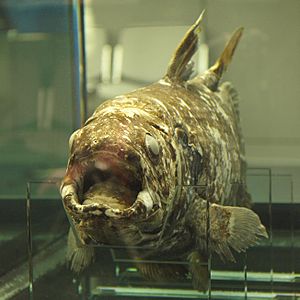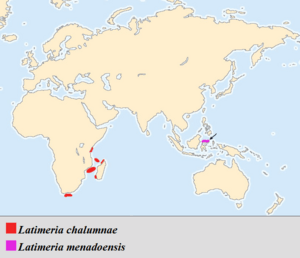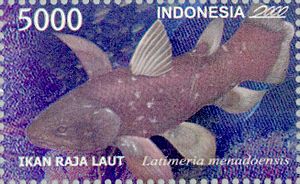Indonesian coelacanth facts for kids
Quick facts for kids Indonesian coelacanth |
|
|---|---|
 |
|
| A preserved Latimeria menadoensis, Tokyo Sea Life Park, Japan | |
| Conservation status | |
| Scientific classification | |
| Genus: |
Latimeria
|
| Species: |
menadoensis
|
 |
|
| L. menadoensis range in violet | |
The Indonesian coelacanth (Latimeria menadoensis) is a very special type of fish. It's one of only two kinds of living coelacanths found today. You can tell it apart by its brownish color. This amazing fish is sometimes called raja laut, which means "king of the sea" in Indonesian. It lives deep in the waters around Indonesia. Scientists consider it a vulnerable species, meaning it needs protection to survive. The other coelacanth species, the West Indian Ocean coelacanth, is in even more danger. You can find Indonesian coelacanths in the waters near north Sulawesi, Papua, and West Papua.
Contents
How This Ancient Fish Was Found
The story of the Indonesian coelacanth's discovery is quite interesting. On September 18, 1997, a couple named Arnaz and Mark Erdmann were on their honeymoon in Indonesia. They saw a strange brown fish at a market in Manado Tua, an island near Sulawesi.
Mark Erdmann thought it looked like a Comoro coelacanth. However, that species is usually blue, not brown. He quickly took some photos before the fish was sold. After realizing this fish was very unique, Erdmann went back to Sulawesi in November 1997. He talked to local fishermen to find more examples.
In July 1998, a fisherman named Om Lameh Sonatham caught another Indonesian coelacanth. This one was 1.2 meters (about 4 feet) long and weighed 29 kilograms (about 64 pounds). He gave the fish to Erdmann. The fish was barely alive but lived for six more hours. This gave Erdmann time to take pictures and observe its movements and colors. The fish was then preserved and given to the Bogor Zoological Museum in Indonesia. Erdmann's exciting discovery was announced in a science magazine called Nature in September 1998.
Scientists later gave this new fish the scientific name Latimeria menadoensis. This name comes from Manado, where the first fish was found. The Indonesian coelacanth is now protected by Indonesian law. Even so, a few have been caught by fishermen since 1998. As of 2018, eight of these rare fish had been found.
What the Indonesian Coelacanth Looks Like
The Indonesian coelacanth, or raja laut, looks a lot like the Comoro coelacanth. The main difference is its color. The Indonesian coelacanth has a brownish-gray skin. The Comoro coelacanth is more bluish.
Both species have white spots all over their bodies. The Indonesian coelacanth also has golden flecks on its body and fins. These flecks shine when light hits them. This fish can grow to be about 1.4 meters (about 4.6 feet) long.
Scientists have studied the DNA of the Indonesian coelacanth. They found that it is genetically different from the Comoro coelacanth. These two species likely separated from each other a very long time ago, about 30 to 40 million years ago. Their DNA is about 4.28% different overall.
Recently, a coelacanth found near Waigeo in West Papua was studied. This study suggests there might be another group of Indonesian coelacanths. This group might have separated from the others about 13 million years ago. Scientists are still trying to figure out if this is a new subspecies or a completely new species.
Where the Indonesian Coelacanth Lives
Scientists have used special underwater vehicles called submersibles to find live Indonesian coelacanths. They have seen them in the waters around Manado Tua and the Talise islands near north Sulawesi. They have also spotted them near Biak in Papua.
These areas are very similar. They have steep, rocky underwater landscapes with many caves. These caves are the perfect home for the coelacanths. These fish live in very deep waters, usually around 150 meters (about 490 feet) or more. The water temperature in their habitat is quite cold, between 14 and 18 degrees Celsius (about 57 to 64 degrees Fahrenheit).
See also
 In Spanish: Celacanto indonesio para niños
In Spanish: Celacanto indonesio para niños



